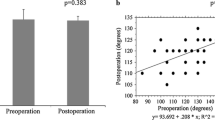Abstract
Purpose
Flexion of the femoral component in 5° increments downsizes the femoral component, decreases the proximal reach and surface area of the trochlea, delays the engagement of the patella during flexion, and is associated with a higher risk of patellar-femoral instability after kinematically aligned TKA. The present study evaluated flexion of the femoral component after use of two kinematic alignment instrumentation systems. We determined whether a distal cutting block attached to a positioning rod inserted perpendicular to the distal femoral joint line in the axial plane and 8–10 cm into the distal femur anterior and posterior to the distal cortex of the femur in the sagittal plane or a femoral patient-specific cutting guide sets the femoral component in more natural flexion.
Methods
Flexion of the femoral component was measured with respect to the sagittal femoral anatomic axis of the distal diaphysis and the sagittal femoral axis on rotationally controlled long-leg lateral computer scanograms. Measurements were performed on 53 consecutive patients treated with a kinematically aligned TKA performed with a distal cutting block attached to a positioning rod, and 53 consecutive patients treated with a kinematically aligned TKA performed with a femoral patient-specific cutting guide.
Results
The average flexion and variability (±standard deviation) of the femoral component of patients treated with a positioning rod was 1° ± 2° and 7° ± 4° with respect to the anatomic and mechanical axes, respectively, which was 5° less than the average flexion of the femoral component of patients treated with a femoral patient-specific cutting guide of 6° ± 4° and 12° ± 5° (p = 0.0001, p = 0.0001, respectively).
Conclusions
Because a distal cutting block attached to a positioning rod sets the femoral component in 5° less flexion and with less variability than a femoral patient-specific cutting guide, we prefer this instrumentation system when performing kinematically aligned TKA to reduce the risk of patellar-femoral instability. Each surgeon should determine the repeatability of setting the flexion of the femoral component with this instrumentation system.






Similar content being viewed by others
References
Aglietti P, Buzzi R, Gaudenzi A (1988) Patellofemoral functional results and complications with the posterior stabilized total condylar knee prosthesis. J Arthroplast 3(1):17–25
Brar AS, Howell SM, Hull ML (2016) What are the bias, imprecision, and limits of agreement for finding the flexion-extension plane of the knee with five tibial reference lines? Knee. doi:10.1016/j.knee.2016.01.005
Dossett HG, Estrada NA, Swartz GJ, LeFevre GW, Kwasman BG (2014) A randomised controlled trial of kinematically and mechanically aligned total knee replacements: two-year clinical results. Bone Joint J 96-B(7):907–913. doi:10.1302/0301-620X.96B7.32812
Dossett HG, Swartz GJ, Estrada NA, LeFevre GW, Kwasman BG (2012) Kinematically versus mechanically aligned total knee arthroplasty. Orthopedics 35(2):e160–e169. doi:10.3928/01477447-20120123-04
Gu Y, Roth JD, Howell SM, Hull ML (2014) How frequently do four methods for mechanically aligning a total knee arthroplasty cause collateral ligament imbalance and change alignment from normal in white patients? J Bone Joint Surg 96(12):e101
Howell SM, Chen J, Hull ML (2013) Variability of the location of the tibial tubercle affects the rotational alignment of the tibial component in kinematically aligned total knee arthroplasty. Knee Surg Sports Traumatol Arthrosc 21(10):2288–2295. doi:10.1007/s00167-012-1987-5
Howell SM, Kuznik K, Hull ML, Siston RA (2010) Longitudinal shapes of the tibia and femur are unrelated and variable. Clin Orthop Relat Res 468(4):1142–1148. doi:10.1007/s11999-009-0984-6
Howell SM, Papadopoulos S, Kuznik K, Ghaly LR, Hull ML (2015) Does varus alignment adversely affect implant survival and function six years after kinematically aligned total knee arthroplasty? Int Orthop 39(11):2117–2124. doi:10.1007/s00264-015-2743-5
Kim YH, Park JW, Kim JS, Park SD (2014) The relationship between the survival of total knee arthroplasty and postoperative coronal, sagittal and rotational alignment of knee prosthesis. Int Orthop 38(2):379–385. doi:10.1007/s00264-013-2097-9
Maderbacher G, Schaumburger J, Baier C, Zeman F, Springorum HR, Birkenbach AM, Grifka J, Keshmiri A (2015) Appropriate sagittal femoral component alignment cannot be ensured by intramedullary alignment rods. Knee Surg Sports Traumatol Arthrosc. doi:10.1007/s00167-015-3541-8
Mahfouz MR, ElHak Abdel Fatah E, Bowers L, Scuderi G (2015) A new method for calculating femoral anterior cortex point location and its effect on component sizing and placement. Clin Orthop Relat Res 473(1):126–132. doi:10.1007/s11999-014-3930-1
Nedopil AJ, Howell SM, Hull ML (2016) Does malrotation of the tibial and femoral components compromise function in kinematically aligned total knee arthroplasty? Orthop Clin N Am 47(1):41–50. doi:10.1016/j.ocl.2015.08.006
Nedopil AJ, Howell SM, Hull ML (2016) What clinical characteristics and radiographic parameters are associated with patellofemoral instability after kinematically aligned total knee arthroplasty? Int Orthop. doi:10.1007/s00264-016-3287-z
Patel J, Ries MD, Bozic KJ (2008) Extensor mechanism complications after total knee arthroplasty. Instr Course Lect 57:283–294
Siston RA, Patel JJ, Goodman SB, Delp SL, Giori NJ (2005) The variability of femoral rotational alignment in total knee arthroplasty. J Bone Jt Surg Am 87(10):2276–2280. doi:10.2106/JBJS.D.02945
Tsukeoka T, Lee TH (2012) Sagittal flexion of the femoral component affects flexion gap and sizing in total knee arthroplasty. J Arthroplast 27(6):1094–1099. doi:10.1016/j.arth.2011.10.015
Author information
Authors and Affiliations
Corresponding author
Ethics declarations
Conflict of interest
The authors have proprietary interests in the materials described in the article. The authors declare that they have no conflict of interest.
Funding
There is no funding source.
Ethical approval
This article does not contain any studies with human participants or animals performed by any of the authors.
Rights and permissions
About this article
Cite this article
Ettinger, M., Calliess, T. & Howell, S.M. Does a positioning rod or a patient-specific guide result in more natural femoral flexion in the concept of kinematically aligned total knee arthroplasty?. Arch Orthop Trauma Surg 137, 105–110 (2017). https://doi.org/10.1007/s00402-016-2598-2
Received:
Published:
Issue Date:
DOI: https://doi.org/10.1007/s00402-016-2598-2




